
Physical Therapy, Stretches, and Massage for Sciatic Pain, Hip Pain, and Pelvic Floor Misalignment
International Journal of Childbirth Education. September 2008
Heather Jeffcoat, DPT
Exercises for Lower Back Pain in Pregnancy
This article discusses exercises for lower back pain in pregnancy–It is a common problem but just doing a few exercises can help reduce the lower back pain in pregnancy. We know you have things to do and can’t be slowed down by lower back pain! This aricle will give you helpful exercises to reduce your lower back pain in pregnancy and can be done postpartum as well.
Sciatic pain? Lower back pain? Hip pain? Any of these sound familiar? What can be done for these women suffering through one of the best times of their lives? So often the advice given is to “just get a massage.” Yes, massages feel WONDERFUL, but unfortunately many women find themselves $100 poorer (plus tip!) and still in pain several hours later. Why does this happen?
Massage techniques are essentially designed to reduce muscle spasm as well as manually stretch the muscles. But this type of treatment offers only symptomatic relief and does not always address the source of the pain. Women’s health physical therapy practitioners are trained to address the source of the pain and provide the pregnant patient with an appropriate treatment plan. Sometimes, this includes massage as a means to decrease the present muscle spasm. However, there are key exercises and education to provide your patients with that can also help so many of these women and oftentimes, prevent the pain from returning.
Potential sources of the pain may include postural dysfunction related to pregnancy, diastasis rectus abdominus (DRA), misalignments in the pelvic girdle, and poor body mechanics. The presence of diastasis rectus abdominus should always be evaluated for and addressed.
Diastasis rectus abdominus is a separation of the rectus abdominus muscle down the midline of the abdomen, at the linea alba. It commonly occurs at the level of the umbilicus, but can occur above, below, or a combination of the three. It usually occurs during the second or third trimester and often persists after delivery if not addressed. Women may not know this separation is occurring. The primary sign is a small or vertical bulge at the women’s midline with standing, and a bulge or gap in the same location when doing a crunch.
If an individual has a diastasis, this contributes to weak abdominal and trunk muscles, poor posture, and low back pain. She will also be unable to do many exercises correctly without injuring or further aggravating her lower back. All strenuous activity or exercise should be avoided until the diastasis is corrected to a two-finger width.
How to check for a diastasis recti:
- Have your patient lie on her back with her knees bent.
- Place two fingers vertically in the middle of her abdomen at the level of the umbilicus.
- Have her lift her head off the floor. Do not have her lift up the shoulders (as in doing a crunch).
- Feel with your fingers if there is a separation occurring.
- Then place your fingers in the same position and check two inches above the umbilicus and two inches below the umbilicus.
- A one-to-two-finger separation is normal. If there is more than a two-finger separation at any of the levels, then your patient has a diastasis recti.
She should also perform the following exercise:
Diastasis Rectus Abdominus Correction:

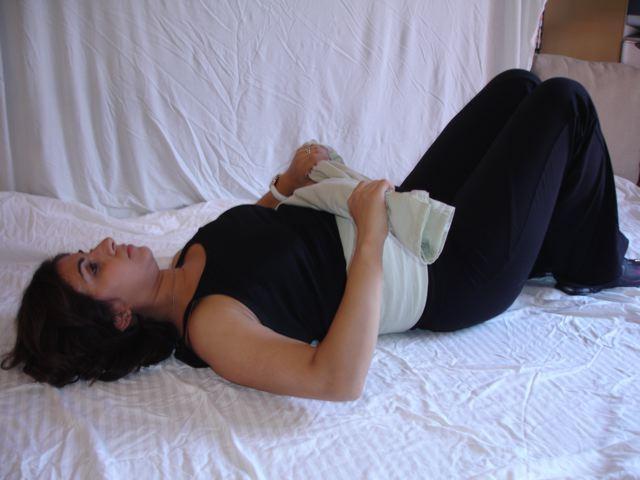
![]()
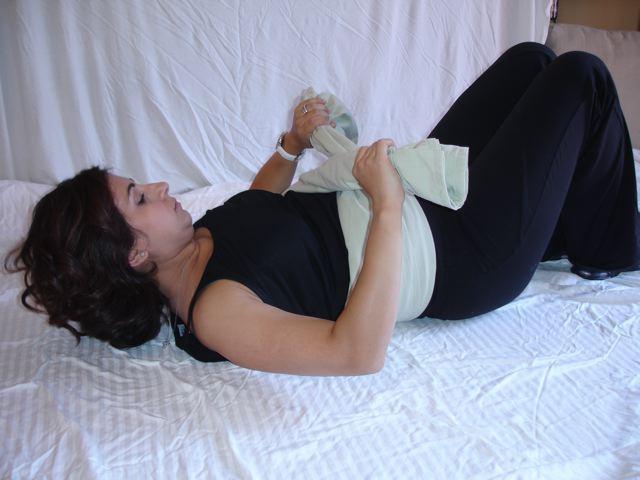
Wrap a towel or sheet around the patient’s waist, at the level of the umbilicus (A). Instruct her to exhale as she lifts her head off the floor, gently squeezing the towel around the abdomen (B). Have her inhale as she lowers the head back down. Begin with 10 repetitions twice a day, and work up to a total of 40 repetitions daily.
Other exercises will be important to incorporate as well, which include stretching and strengthening of the involved areas. However, there are some considerations that should be taken into account when recommending any exercise to a pregnant patient. If flexibility is the desired goal, focus on maintaining normal joint range of motion. Do not encourage excessive muscle flexibility during pregnancy due to ligamentous laxity. Be especially careful to prevent hyperextension at the knees and elbows (think of having a slight bend in the knees and elbows). Furthermore, jerky or bouncing movements should be avoided. Due to a pregnant women’s changing center of gravity, balance is affected, although no data supports an increase in fall risk. Still, exercises where there is a potential loss of balance, and therefore trauma to the abdomen, should be avoided.
The following list of exercises is generally appropriate for pregnant patients who complain of the orthopedic ailments listed above. However, if the pain is severe, or does not improve with the following exercises, referral to a women’s health physical therapist is in order. The patient should feel better after completing the exercise. If an increase in pain occurs, she is likely stretching with too much intensity or the exercise is not appropriate for the cause of her pain.
Gluteal Stretch:

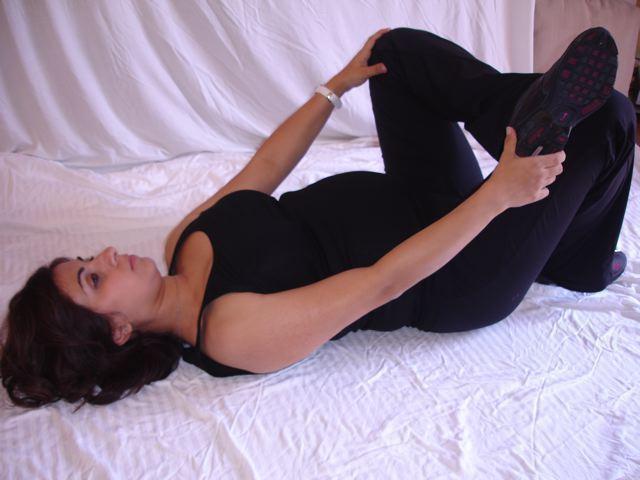
![]()
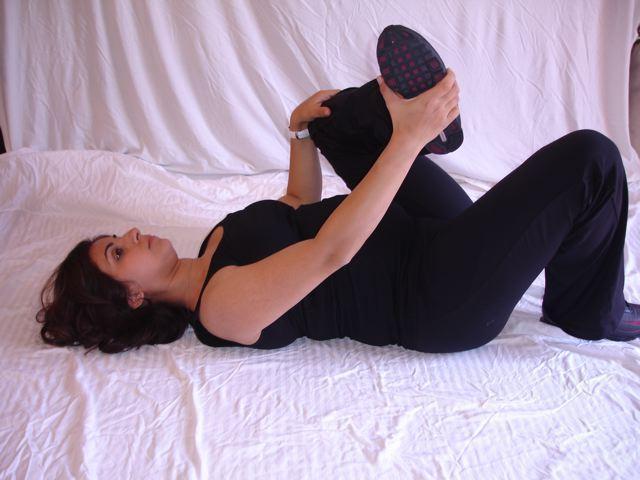
Instruct the patient to place her ankle over her opposite thigh (A). Then, have her slowly pull her top leg towards her chest until a gentle stretch is felt in the buttock and thigh (B). Hold for 30 seconds, repeat twice on each leg. Have her perform this exercise two to three times a day until the pain subsides.
Hamstring stretch and sciatic nerve glide:

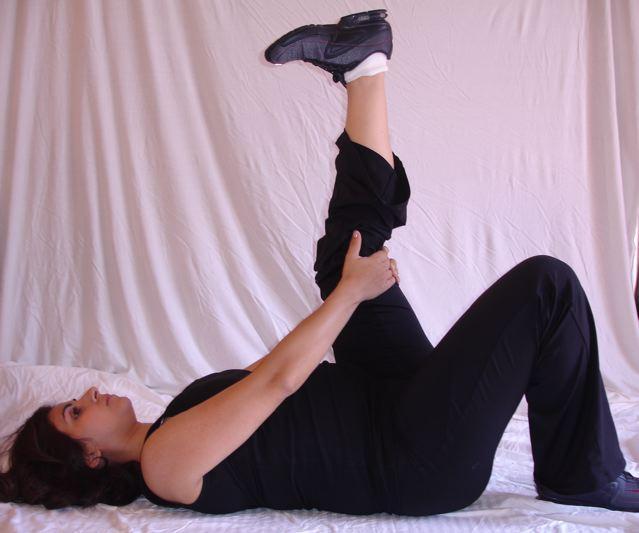
![]()
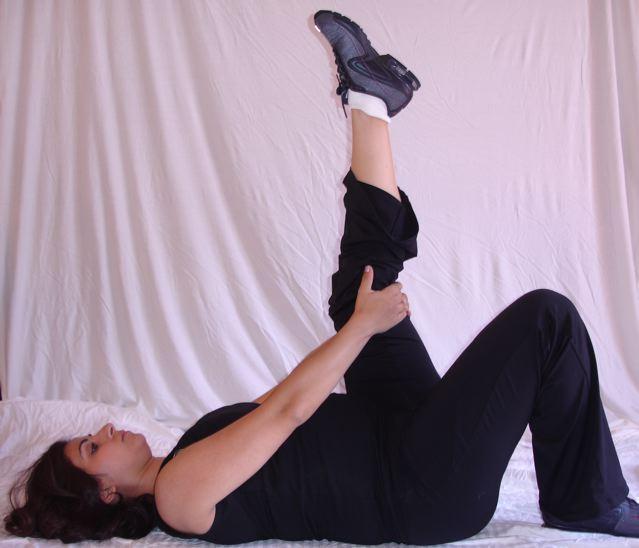
Instruct the patient to hold the back of her leg, as pictured, and slowly straighten her knee until a gentle stretch is felt in the back of her thigh (A). Hold for 30 seconds, repeat twice. Then, have her slowly point and flex her ankle to move the sciatic nerve for 10 repetitions B). Perform this exercise two to three times a day until the pain subsides.
Child’s pose stretch:


![]()
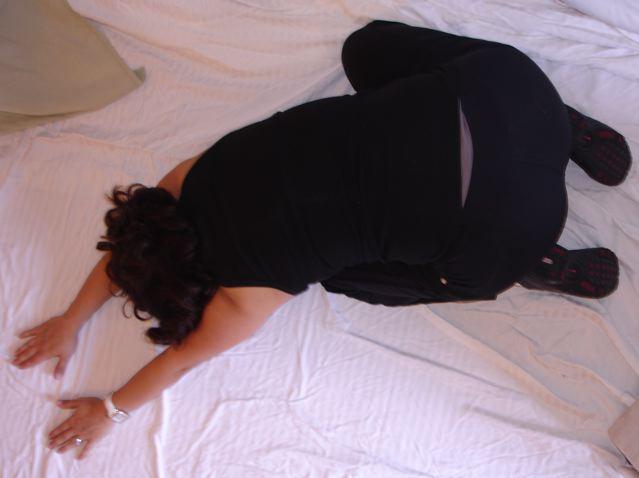
![]()
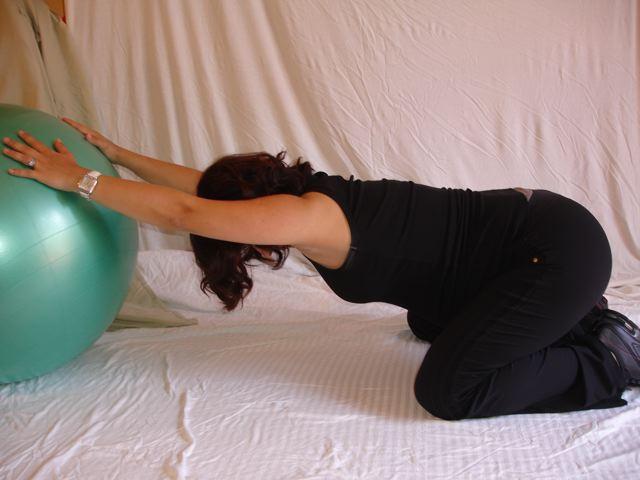
Have the patient get into the position above (A), spreading her hips and knees apart to make room for the belly. Keep the heels pressed to the bottom and reach the arms straight ahead. Hold for 30 seconds. Now, have her slowly walk her hands to the left, deepening the stretch on the right side of the torso (B). Hold for 30 seconds. Repeat to the right side. Perform this exercise two to three times a day until the pain subsides. This exercise may also be performed using a birthing ball, to provide for a greater thoracic spine stretch into extension (C).
Side-lying quad stretch:
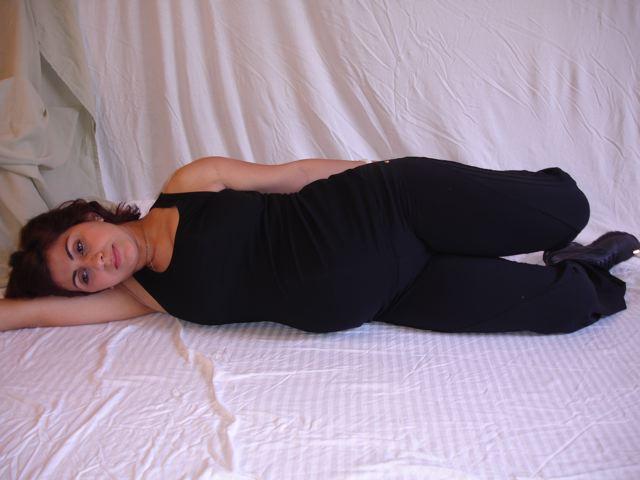
Have the patient lie on her side and hold her ankle as she gently pulls the leg back. Make sure the thigh is in line with the body. Hold for 30 seconds, repeat twice on each leg. Perform this exercise two to three times a day until the pain subsides.
Gentle strengthening exercises can also be performed, as this will help with supporting the weight of the expanding abdomen throughout pregnancy and take stress off of the lower back.
Pelvic tilts, with ball squeeze:

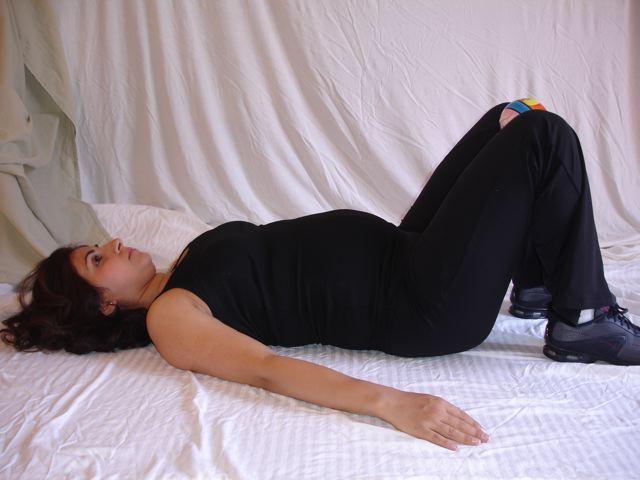
![]()
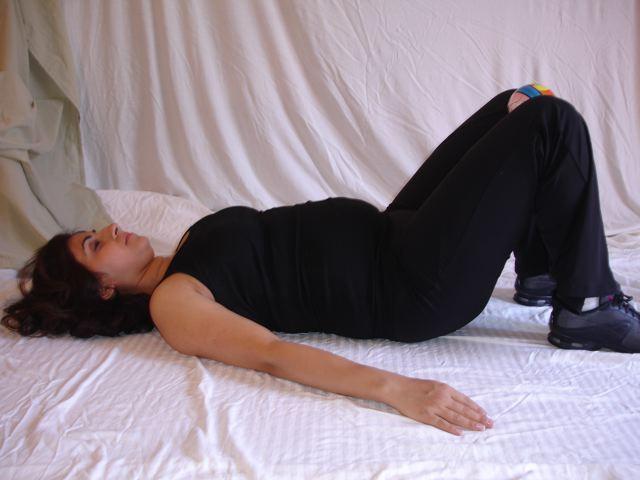
Have the patient lie on her back, heels two inches apart. Place a small ball between the knees (A). Have her exhale as she squeezes the ball and presses her back into the floor (B). Inhale, return to the start position. Repeat for 15 repetitions, one to two times per day. There should be no bulging through the abdomen (i.e., a worsening of the DRA). Rather, the navel should gently pull down toward the spine.
Pelvic tilts on birthing ball:

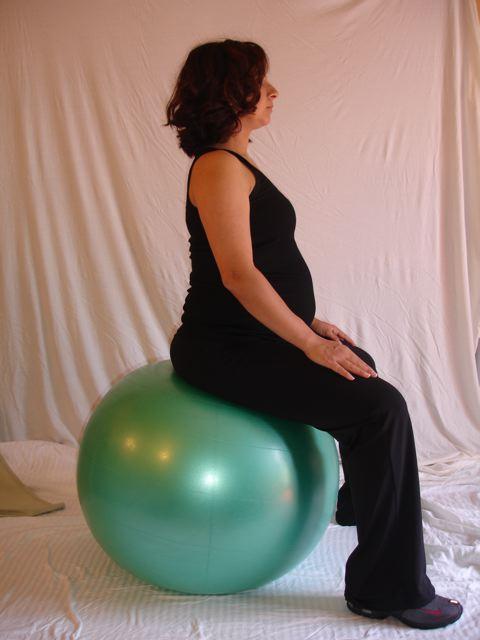
![]()
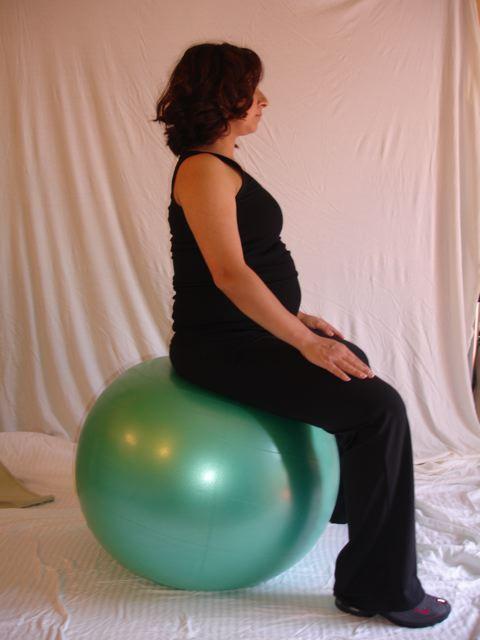
Have the patient sit on the ball as pictured in (A), with her spine in a neutral position. Have her exhale as she tucks the belly up towards the chest (B). Inhale back to her start position. The shoulders and upper back should still be erect, as pictured in (B). Do not bring the chest down to the belly, which will cause her to appear slumped over. Do 10-15 repetitions, one to two times a day.
Side-lying clams:
![]()

![]()
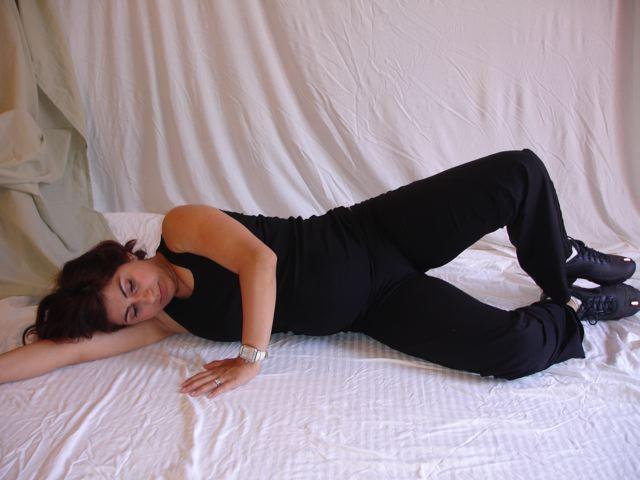
Have the patient lie on her side with her hips and legs stacked on one another. Cue her to gently pull her navel towards her spine as she inhales. Keep that tension in the navel as she opens her knees apart. Do not allow her spine to twist backward. Repeat for 10-15 repetitions, once per day.
Quadruped pelvic tilts:

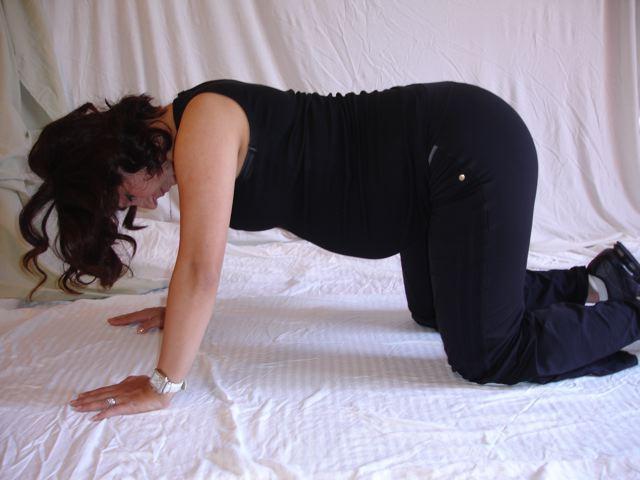
![]()
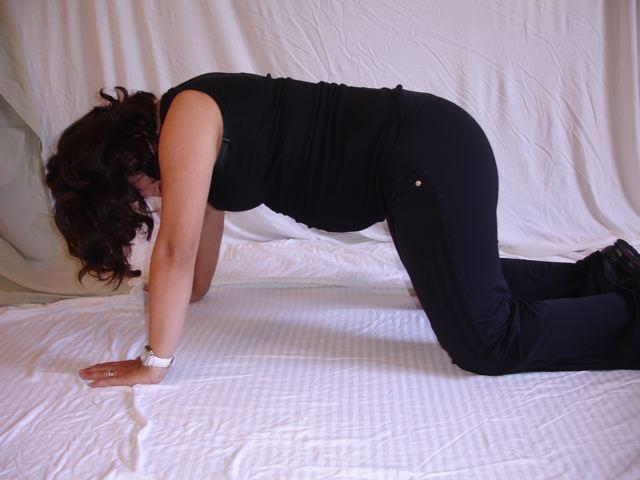
Have the patient go onto her hands and knees as pictured (A), keeping the spine in a neutral position. Have her exhale as she tucks the pelvis, flattening the lower back without curving the entire spine (B). Perform 8 to10 repetitions, once per day.
Mini-squats:

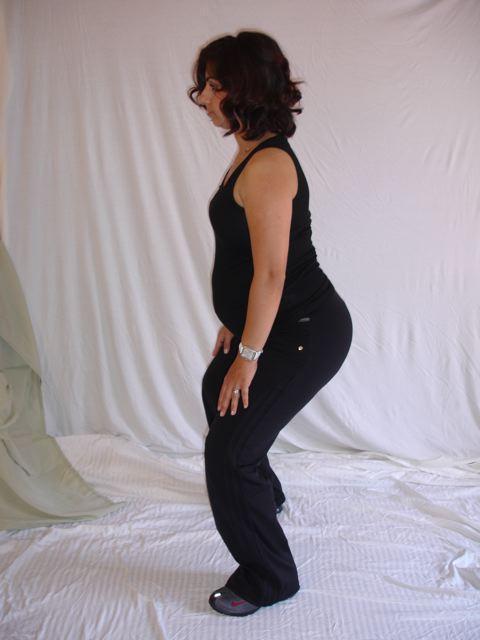
![]()
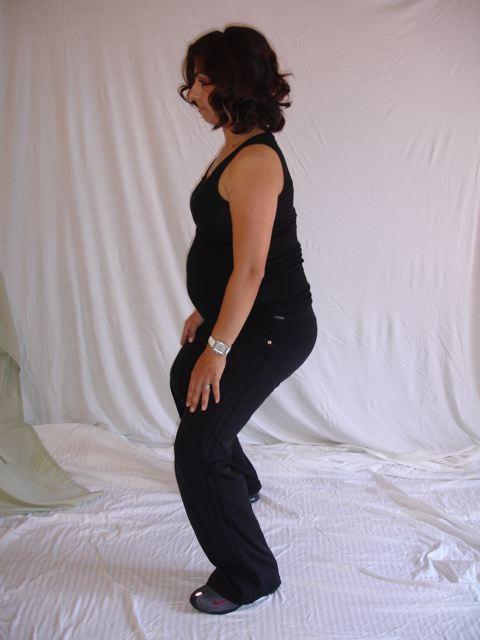
Have the patient stand with her feet just wider than hip-width apart with her hips and knees turned out, as pictured. Now, have her go into a partial squat, as deep as is comfortable and feels balanced. Count to three slowly going down, and then to three again going up. Perform 15-20 repetitions, once per day.
As with any exercise program for pregnant women, watch for warning signs that indicate there may be a problem. The American College of Obstetricians and Gynecologists reports that after the first trimester, the supine position results in relative obstruction of venous return and therefore decreased cardiac output. For this reason, supine positions should be avoided as much as possible during rest and exercise.
It later states that exertion in supine in particular should be avoided. If performing gentle supine exercises, I recommend breaking every five minutes at a minimum to take pressure off of the vena cava. According to the ACOG, if a pregnant patient exhibits any of the signs or symptoms below, do not exercise.
- Dizziness or faintness
- Increased shortness of breath
- Uneven or rapid heartbeat
- Chest pain
- Trouble walking
- Calf pain or swelling
- Headache
- Vaginal bleeding
- Uterine contractions that continue after rest
- Fluid gushing or leaking from the vagina
- Decreased fetal movement
Furthermore, before a patient arises from a horizontal position, she should take one or two deep breaths. If she was supine, she should first roll to her side and wait before sitting up to avoid supine hypotension. The patient should then wait a moment before standing all the way to minimize dizziness (orthostatic hypotension).
Additionally, any position or movement that causes a patient to hold her breath is too strenuous. This will increase intra-abdominal pressure and strain the abdominal wall and pelvic floor muscles. If abdominal bulging is observed through the separated rectus abdominus, the exercise being performed is likely too difficult and should be modified or discontinued if modification is not possible.
A pelvic floor physical therapist can assist you with finding other potential causes of lower back pain in pregnancy and provide a more directed treatment plan. Visit us at our Los Angeles office or reach out to us for a Coaching or Telehealth session so you can start feeling better today!
References:
ACOG, 2005. Your pregnancy and birth. Washington, DC: Meredith Books.
Artal, R., O’Toole M. 2003. Guidelines of the American College of Obstetricians and Gynecologists for Exercise During Pregnancy and the Postpartum Period. British Journal of Sports Medicine 37: 6-12.
Creager, C. 2001. Bounce back into shape after baby: the ultimate guide to a fun-filled, time and energy efficient workout with your baby. Colorado: Executive Physical Therapy, Inc.
Noble, E. 1995. Essential exercises for the childbearing year: a guide to health and comfort before and after your baby is born. Massachusetts: New Life Images.
Shrock, P., Simkin, P., Shearer, M. 1981. Teaching prenatal exercise: Part II—Exercises to think twice about. Birth and the Family Journal 8:3 167-175.
Stephenson, R., O’Connor, L. 2000. Obstetric and Gynecologic Care in Physical Therapy. New Jersey: Slack, Inc.
